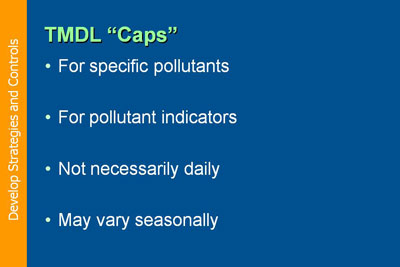TMDL Caps
TMDLs are developed for several pollutants and water body types. TMDL developers use a wide variety of analytical approaches depending on available data, watershed and water body characteristics, and available budgets. EPA recommends that all TMDLs and associated load allocations and wasteload allocations be expressed in terms of daily time increments. In addition to daily time increments, TMDLs may also include non-daily pollutant load expressions to attain and maintain the applicable water quality standards. In an effort to fully understand the physical and chemical dynamics of a water body, many TMDLs are developed using methodologies that result in identified allocations of monthly or greater time periods. TMDLs commonly include time steps ranging from daily to annual to express the loading capacity and associated allocations. EPA encourages TMDL developers to apply accepted and reasonable methodologies when calculating TMDLs and to use the most appropriate averaging period for developing allocations based on factors such as available data, watershed and water body characteristics, pollutant loading considerations, applicable standards, and the TMDL development methodology, among other things. For example, in the case of a narrative criteria applicable to sediment, attaining WQS cannot always be judged daily. Assessing cumulative loading impacts is necessary to understand how to achieve WQS and to estimate the allowable loading capacity.
For more information on the technical approach related to TMDL averaging periods and methods, see Options for Expressing Daily Loads in TMDLs.
![[logo] US EPA](https://www.epa.gov/epafiles/images/logo_epaseal.gif)
